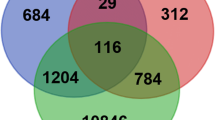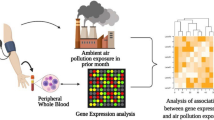Abstract
Purpose
To identify changes in gene expression in the airways among welders, with and without lower airway symptoms, working in black steel.
Methods
Included were 25 male, non-smoking welders. Each welder was sampled twice; before exposure (after vacation), and after 1 month of exposure. From the welders (14 symptomatic, of whom 7 had asthma-like symptoms), RNA from induced sputum was obtained for gene expression analysis. Messenger RNA from a subset of the samples (n = 7) was analysed with microarray technology to identify genes of interest. These genes were further analysed using quantitative PCR (qPCR; n = 22).
Results
By comparing samples before and after exposure, the microarray analysis resulted in several functional annotation clusters: the one with the highest enrichment score contained “response to wounding”, “inflammatory response” and “defence response”. Seven genes were analysed by qPCR: granulocyte colony-stimulating factor 3 receptor (CSF3R), superoxide dismutase 2, interleukin 8, glutathione S-transferase pi 1, tumour necrosis factor alpha-induced protein 6 (TNFAIP6), interleukin 1 receptor type II and matrix metallopeptidase 25 (MMP25). Increased levels of CSF3R, TNFAIP6 and MMP25 were indicated among asthmatic subjects compared to non-symptomatic subjects, although the differences did not reach significance.
Conclusions
Workers’ exposure to welding fumes changed gene expression in the lower airways in genes involved in inflammatory and defence response. Thus, microarray and qPCR technique can demonstrate markers of exposure to welding fumes and possible disease-related markers. However, further studies are needed to verify genes involved and to further characterise the mechanism for welding fumes-associated lower airway symptoms.


Similar content being viewed by others
References
Alexis NE, Hu SC, Zeman K, Alter T, Bennett WD (2001) Induced sputum derives from the central airways: confirmation using a radiolabeled aerosol bolus delivery technique. Am J Respir Crit Care Med 164:1964–1970
Alexis NE, Brickey WJ, Lay JC, Wang Y, Roubey RA, Ting JP et al (2008) Development of an inhaled endotoxin challenge protocol for characterizing evoked cell surface phenotype and genomic responses of airway cells in allergic individuals. Ann Allergy Asthma Immunol 100:206–215
Antonini JM (2003) Health effects of welding. Crit Rev Toxicol 33:61–103
Baines KJ, Wood LG, Gibson PG (2009) The nutrigenomics of asthma: molecular mechanisms of airway neutrophilia following dietary antioxidant withdrawal. OMICS 13:355–365
Boelter FW, Simmons CE, Berman L, Scheff P (2009) Two-zone model application to breathing zone and area welding fume concentration data. J Occup Environ Hyg 6:298–306
Colotta F, Re F, Muzio M, Bertini R, Polentarutti N, Sironi M et al (1993) Interleukin-1 type II receptor: a decoy target for IL-1 that is regulated by IL-4. Science 261:472–475
Contreras GR, Chan-Yeung M (1997) Bronchial reactions to exposure to welding fumes. Occup Environ Med 54:836–839
Ferris BG (1978) Epidemiology standardization project (American thoracic society). Am Rev Respir Dis 118:1–120
Fireman E, Lerman Y, Stark M, Schwartz Y, Ganor E, Grinberg N et al (2008) Detection of occult lung impairment in welders by induced sputum particles and breath oxidation. Am J Ind Med 51:503–511
Forteza R, Casalino-Matsuda SM, Monzon ME, Fries E, Rugg MS, Milner CM et al (2007) TSG-6 potentiates the antitissue kallikrein activity of inter-alpha-inhibitor through bikunin release. Am J Respir Cell Mol Biol 36:20–31
Hamilton JA (2008) Colony-stimulating factors in inflammation and autoimmunity. Nat Rev Immunol 8:533–544
Hayes JD, Flanagan JU, Jowsey IR (2005) Glutathione transferases. Annu Rev Pharmacol Toxicol 45:51–88
Jönsson G, Staaf J, Olsson E, Heidenblad M, Vallon-Christersson J, Osoegawa K et al (2007) High-resolution genomic profiles of breast cancer cell lines assessed by tiling BAC array comparative genomic hybridization. Genes Chromosomes Cancer 46:543–558
Kang T, Yi J, Guo A, Wang X, Overall CM, Jiang W et al (2001) Subcellular distribution and cytokine- and chemokine-regulated secretion of leukolysin/MT6-MMP/MMP-25 in neutrophils. J Biol Chem 276:21960–21968
Landis GN, Tower J (2005) Superoxide dismutase evolution and life span regulation. Mech Ageing Dev 126:365–379
Larsson B, Karlsson JE, Nielsen J (2007) Respiratory and ocular symptoms in workers exposed to potassium aluminium-tetrafluoride soldering flux. Int Arch Occup Environ Health 80:627–633
Li J, Kartha S, Iasvovskaia S, Tan A, Bhat RK, Manaligod JM et al (2002) Regulation of human airway epithelial cell IL-8 expression by MAP kinases. Am J Physiol Lung Cell Mol Physiol 283:L690–L699
Lilly CM, Tateno H, Oguma T, Israel E, Sonna LA (2005) Effects of allergen challenge on airway epithelial cell gene expression. Am J Respir Crit Care Med 171:579–586
Littorin M, Rylander L, Skarping G, Dalene M, Welinder H, Strömberg U et al (2000) Exposure biomarkers and risk from gluing and heating of polyurethane: a cross sectional study of respiratory symptoms. Occup Environ Med 57:396–405
Maestrelli P, Calcagni PG, Saetta M, Di Stefano A, Hosselet JJ, Santonastaso A et al (1994) Sputum eosinophilia after asthmatic responses induced by isocyanates in sensitized subjects. Clin Exp Allergy 24:29–34
McNeilly JD, Heal MR, Beverland IJ, Howe A, Gibson MD, Hibbs LR et al (2004) Soluble transition metals cause the pro-inflammatory effects of welding fumes in vitro. Toxicol Appl Pharmacol 196:95–107
Medical Research Council Committee on etiology of chronic bronchitis (1965) The Lancet 777–779
Milner CM, Day AJ (2003) TSG-6: a multifunctional protein associated with inflammation. J Cell Sci 116:1863–1873
Nie J, Pei D (2004) Rapid inactivation of alpha-1-proteinase inhibitor by neutrophil specific leukolysin/membrane-type matrix metalloproteinase 6. Exp Cell Res 296:145–150
Oh JH, Yang MJ, Yang YS, Park HJ, Heo SH, Lee EH et al (2009) Microarray-based analysis of the lung recovery process after stainless-steel welding fume exposure in Sprague-Dawley rats. Inhal Toxicol 21:347–373
Rim KT, Park KK, Sung JH, Chung YH, Han JH, Cho KS et al (2004) Gene-expression profiling using suppression-subtractive hybridization and cDNA microarray in rat mononuclear cells in response to welding-fume exposure. Toxicol Ind Health 20:77–88
Rim KT, Park KK, Kim YH, Lee YH, Han JH, Chung YH et al (2007) Gene-expression profiling of human mononuclear cells from welders using cDNA microarray. J Toxicol Environ Health A 70:1264–1277
Rolph MS, Sisavanh M, Liu SM, Mackay CR (2006) Clues to asthma pathogenesis from microarray expression studies. Pharmacol Ther 109:284–294
Saal LH, Troein C, Vallon-Christersson J, Gruvberger S, Borg A, Peterson C (2002) BioArray Software Environment (BASE): a platform for comprehensive management and analysis of microarray data. Genome Biol 3:SOFTWARE0003
Wang Z, Neuburg D, Li C, Su L, Kim JY, Chen JC et al (2005) Global gene expression profiling in whole-blood samples from individuals exposed to metal fumes. Environ Health Perspect 113:233–241
Wang Z, Neuberg D, Su L, Kim JY, Chen JC, Christiani DC (2008) Prospective study of metal fume-induced responses of global gene expression profiling in whole blood. Inhal Toxicol 20:1233–1244
Yang MC, Ruan QG, Yang JJ, Eckenrode S, Wu S, McIndoe RA et al (2001) A statistical method for flagging weak spots improves normalization and ratio estimates in microarrays. Physiol Genomics 7:45–53
Acknowledgments
We thank Ellen Tufvesson for introduction to the method of induced sputum, Ulla Andersson, Eva Assarsson, Inger Bensryd, Kerstin Diab, Karin Engström and Karin Paulsson for help collecting the samples, and Eleonor Olsson for help with the microarray analysis. Furthermore, we thank Anna Axmon and Helene Jakobsson for their statistical assistance. The study was financially supported by Swedish Research Council (FAS) and The Knut and Alice Wallenberg Foundation (SWEGENE Program).
Author information
Authors and Affiliations
Corresponding author
Rights and permissions
About this article
Cite this article
Jönsson, L.S., Nielsen, J. & Broberg, K. Gene expression analysis in induced sputum from welders with and without airway-related symptoms. Int Arch Occup Environ Health 84, 105–113 (2011). https://doi.org/10.1007/s00420-010-0579-2
Received:
Accepted:
Published:
Issue Date:
DOI: https://doi.org/10.1007/s00420-010-0579-2




